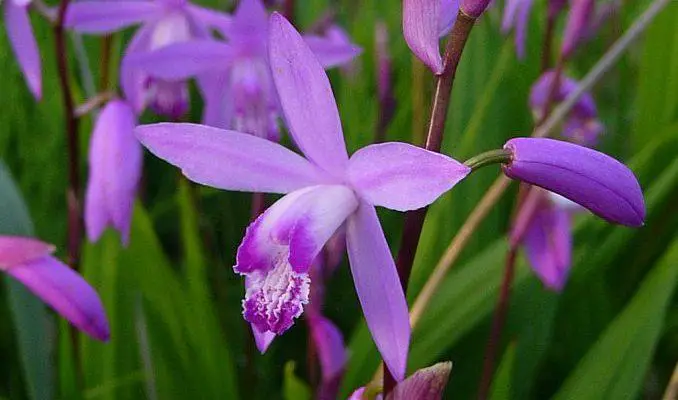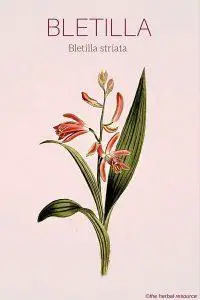Botanical Name: Bletilla striata.
Other Common Names: Hardy orchid, Chinese ground orchid, urn orchid, hyacinth bletilla, Japanorchidee (German), mikadoblomst (Danish), shiran (Japanese), bai ji (Chinese).
Habitat: Bletilla grows wild in the southern and eastern parts of China, Japan, Hong Kong and on some Pacific islands.
The cultivation of the plant for use in herbal medicine takes place mostly in the Guizhou Province in China.
In Europe and the United States, it is grown as an ornamental garden or a pot plant.
Plant Description: Bletilla striata is of the Orchidaceae family. The genus “Bletilla” contains nine or 10 species of orchids that are named after the Spanish botanist Don Louis Blet. The rhizome produces lanceolate, folded leaves that are light green.
From the center of each mound rises a curving flower stalk that is 25 cm long or more and extends over the leaves. Six to 12 purple to pink flowers, around 3 to 5 cm in diameter, emerge from April to June, depending on the climate. When the plants are grown indoors in pots, they can also bloom in midwinter.
Plant Parts Used:: The rhizomes (tubers) are used in herbal medicine. The small roots and root bark are removed, and the rhizomes are washed and dried in the sun before they’re cut, sliced or ground into a fine powder.
Therapeutic Uses, Benefits and Claims of Bletilla
The main substances found in the plant are gelatin, essential oil, stilbenoids, blespirol, and phenanthrene glucosides.
In Western herbal medicine, the rhizome (root) is known for its astringent, expectorant and emollient (due to the high mucus content of the plant) properties and it has been used to treat indigestion, dysentery and fever.
The herb is rarely used in Western herbal medicine.
Very few people who grow this plant for ornamental reasons are aware of its value as a medicinal herb and its importance in Chinese herbal medicine.
Bletilla is classified as a bitter, slightly cool and slightly sweet herb. When consumed, it is bitter at first but gets sweeter when it is chewed on for a while.
It is an important wound-healing herb in traditional Chinese herbal medicine and it was first described in Chinese medical literature in about 500 A.D. The herb was used to reduce swelling, promote the formation of tissue and stop bleeding.
Bletilla striata is used in mixtures intended to treat chronic cough, tuberculosis and inflammation of the trachea associated with bronchitis.
It is also used to treat hemoptysis (coughing up blood from the respiratory tract) and stop bleeding due to stomach ulcers.
Furthermore, it is used as a hemostatic agent for bleeding from the urinary tract, rectal bleeding, epistaxis (nose bleed) and some traumatic bleeding.
Powder made from the root (rhizome) is used externally as an herbal treatment for boils, swelling, acne sores and dry cracked hands and feet.
It is also used to treat burns and chilblains, a foot condition.
Preliminary research has indicated that the rhizomes of bletilla have some inhibitory effect on Mycobacterium tuberculosis and that the herb can be used as a treatment of pulmonary tuberculosis (TB).
In one study the powdered root was given to 60 chronic tuberculosis patients who had failed standard therapy. After taking the herb for three months, 42 patients were reported clinically healthy, 13 showed significant improvement while two showed no change.
Similar results have been found in other studies. Supporting Reference: Clinical Gerontology Unit, University of Cambridge School of Medicine, Addenbrooke’s Hospital, Cambridge, United Kingdom.
Dosage and Administration
To stop bleeding in the stomach or intestines, take 6 g of the powdered root three times daily.
To treat hemoptysis or bleeding from the rectum, bletilla can be used in a combination with great burnet (Sanguisorba officinalis) and hairy agrimony (Agrimonia pilosa).
Those two herbs have also been used in Western herbal medicine to stop bleeding. Powder from the three herbs are mixed together and made into a paste for consumption.
Possible Side Effects and Interactions of Bletilla
The bletilla root should not be used with any preparations that include plant species of the genus Aconitum.
Also, the herb should not be applied for chronic lung inflammation.
If the herb is used in large doses for a long period of time, it is toxic.
Use the herb only in consultation with a therapist or a trained herbalist who has experience and knowledge on Chinese herbal medicine.
Other Resources on Bletilla
Hardy Bletillas by Clark T. Riley
Supporting References
Bown Deni. Encyclopaedia of Herbs and Their Uses. London. Dorling Kindersley, 1995.
Yeung, HC. Handbook of Chinese Herbs and Formulas. Los Angeles. Institute of Chinese Medicine, 1985.
Wu, Jing-Nuan: An Illustrated Chinese Materia Medica. New York- Oxford University Press 2005.
Tierra, Michael: The Way of Chinese Herbs. New York, Pocket Books 1998.
Foster, Steven & Yue Chongxi: Herbal Emissaries. Bringing Chinese Herbs to the West. Rochester, Vermont. Healing Arts Press 1992.
Bown, Deni: The Royal Horticultural Society New Encyclopedia of Herbs & Their Uses. London. Dorling Kindersley 2002.
Thordur Sturluson
Latest posts by Thordur Sturluson (see all)
- What is the Difference Between Hemp and Marijuana? - June 3, 2019


Leave a Reply